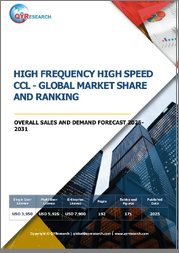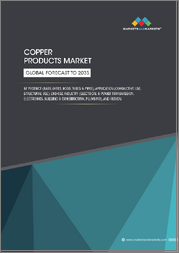
|
시장보고서
상품코드
1771520
세계의 구리 시장 규모, 점유율, 동향 분석 보고서 : 종류별, 제품별, 최종 용도별, 지역별, 부문별 예측(2025-2030년)Copper Market Size, Share & Trends Analysis Report By Type (Primary Copper, Secondary Copper), By Product (Wire, Tube, Foil), By End Use (Industrial Equipment, Transport, Infrastructure), By Region, And Segment Forecasts, 2025 - 2030 |
||||||
구리 시장 성장과 동향:
Grand View Research, Inc.의 새로운 보고서에 따르면, 세계 구리 시장 규모는 2030년까지 3,399억 5,000만 달러에 달할 것으로 예상되며, 2025년부터 2030년까지 CAGR 6.5%로 성장할 것으로 예상됩니다.
구리는 우수한 전도성, 내식성, 내구성으로 인해 건설 분야에서 없어서는 안 될 필수 요소입니다. 배선, 배관, 지붕, 난방 시스템 등에 폭넓게 사용되고 있습니다. 인도, 베트남, 아프리카 국가 등 신흥국들이 스마트 시티, 교통망, 현대식 주택에 많은 투자를 계속하고 있기 때문에 주거 및 상업용 건축에서 구리의 수요는 향후 몇 년 동안 크게 증가할 것으로 예상됩니다.
또 다른 큰 원동력은 재생에너지로의 전환과 전기화입니다. 태양광 및 풍력발전 설비에는 터빈, 태양전지, 인버터, 송전망 연결에 대량의 구리가 필요합니다. 국제에너지기구(IEA)에 따르면, 재생에너지에 대한 투자는 2024년에 기록적인 수준에 도달할 것이며, 특히 아시아태평양, 유럽, 북미에서 두드러질 것입니다. 또한, 간헐적인 재생에너지를 통합하는 데 필수적인 스마트 그리드 및 배터리 저장 시스템의 개발은 구리 배선 및 부품에 크게 의존하고 있습니다. 이러한 에너지 전환은 전 세계적으로 구리의 소비 패턴을 근본적으로 변화시키고 있습니다.
전기자동차(EV)와 이를 지원하는 인프라의 등장은 또 하나의 강력한 성장 촉매제입니다. 특히 배터리, 전기 모터, 와이어링 하니스, 열 관리 시스템 등에 많이 사용되고 있습니다. 유럽, 미국, 중국에서 급증하고 있는 충전소도 에너지 전송을 위해 구리를 사용하고 있습니다. 각국 정부가 보다 엄격한 배기가스 규제를 도입하고 전기자동차 보급을 촉진하는 인센티브를 도입함에 따라 자동차 산업의 구리 수요는 2030년 이후 비약적으로 증가할 것으로 예상됩니다.
전자기기와 통신의 기술 발전도 구리 산업의 성장에 크게 기여하고 있습니다. 구리는 스마트폰, 데이터센터, IoT 기기, 5G 인프라에 사용되는 인쇄회로기판, 커넥터, 반도체, 고주파 데이터 케이블에 필수적입니다. 세계 경제의 디지털화가 진행됨에 따라 전자기기와 클라우드 컴퓨팅의 보급이 확대되면서 고순도 구리 제품에 대한 수요가 증가하고 있습니다. 이 분야는 소비자 전자제품 제조가 집중되어 있는 동아시아에서 특히 강세를 보이고 있습니다.
또한, 지속가능성과 순환 경제에 대한 관심이 높아짐에 따라 구리의 재활용에 대한 관심도 높아지고 있습니다. 재활용 및 2차 가공된 구리는 생산에 필요한 에너지가 훨씬 적고, 채굴로 인한 환경 영향도 적습니다. 산업계가 탄소 중립과 재료의 효율성을 우선시함에 따라 스크랩 금속, 오래된 전자제품, 폐기된 인프라에서 구리를 재활용하려는 움직임이 증가할 것으로 예상됩니다. 이는 수요를 뒷받침하고, 광석 가격의 변동과 지정학적 불확실성 속에서 공급망의 강인성을 높이고 있습니다. 이러한 요인들로 인해 세계 구리 산업은 장기적으로 크게 성장할 것으로 예상됩니다.
구리 시장 : 분석 개요
- 구리 종류별로는 1차 구리 부문이 2024년 84.8%의 가장 큰 매출 점유율로 시장을 주도했습니다.
- 동선 부문은 2024년 61.7%의 가장 큰 매출 점유율로 시장을 주도했습니다. 이는 송전, 주거용 및 상업용 전기 시스템, 전자제품, 그리고 효율적이고 신뢰할 수 있는 전도성 솔루션을 필요로 하는 전기자동차 및 재생에너지 분야에서 동선이 널리 사용되고 있기 때문입니다.
- 이는 스마트 그리드, 교통망, 재생에너지 통합, 도시 개발 프로젝트에 대한 전 세계 투자 증가에 기인합니다.
- 아시아태평양은 중국, 인도 등 주요 구리 소비국가의 존재, 급속한 산업화, 대규모 인프라 개발, 전자제품 제조, 재생에너지 설비, 전기자동차 생산에서 주도권을 쥐고 있어 2024년 74.7%의 가장 큰 매출 점유율로 시장을 독점했습니다.
목차
제1장 분석 방법·범위
제2장 주요 요약
제3장 시장 변수, 동향, 범위
- 세계의 구리 시장 전망
- 업계의 밸류체인 분석
- 판매 채널 분석
- 기술 개요
- 규제 프레임워크
- 시장 역학
- 시장 성장 촉진요인 분석
- 시장 성장 억제요인 분석
- 업계 동향
- 무역 전망
- ESG 동향
- 경제 동향
- Porter's Five Forces 분석
- 공급업체의 협상력
- 구매자의 협상력
- 대체의 위협
- 신규 진출 기업의 위협
- 경쟁 기업 간의 경쟁 관계
- PESTEL 분석
- 정치적 요인
- 경제적 요인
- 사회적 요인
- 기술적 요인
- 환경적 요인
- 법적 요인
제4장 구리 시장 : 종류별 추정·동향 분석
- 구리 시장 : 변동 분석, 종류별(2024년·2030년)
- 1차 구리
- 2차 구리
제5장 구리 시장 : 제품별 추정·동향 분석
- 구리 시장 : 변동 분석, 제품별(2024년·2030년)
- 구리선
- 구리봉·절편
- 압연 제품
- 튜브
- 포일
제6장 구리 시장 : 최종 용도별 추정·동향 분석
- 구리 시장 : 변동 분석, 최종 용도별(2024년·2030년)
- 산업 기기
- 운송
- 인프라
- 건축·건설
- 소비재·일반 제품
- 기타
제7장 구리 시장 : 지역별 추정·동향 분석
- 지역별 분석(2024년·2030년)
- 북미
- 종류별(2018-2030년)
- 제품별(2018-2030년)
- 최종 용도별(2018-2030년)
- 미국
- 캐나다
- 멕시코
- 유럽
- 종류별(2018-2030년)
- 제품별(2018-2030년)
- 최종 용도별(2018-2030년)
- 독일
- 이탈리아
- 러시아
- 프랑스
- 아시아태평양
- 종류별(2018-2030년)
- 제품별(2018-2030년)
- 최종 용도별(2018-2030년)
- 중국
- 인도
- 일본
- 한국
- 라틴아메리카
- 종류별(2018-2030년)
- 제품별(2018-2030년)
- 최종 용도별(2018-2030년)
- 브라질
- 중동 및 아프리카
- 종류별(2018-2030년)
- 제품별(2018-2030년)
- 최종 용도별(2018-2030년)
- 사우디아라비아
- 아랍에미리트
제8장 경쟁 구도
- 최근 동향과 영향 분석 : 주요 기업별
- 기업 분류
- 히트맵 분석
- 벤더 상황
- 판매대리점 리스트
- 유망한 최종사용자 리스트
- 전략상의 대처
- 기업 개요/상장 기업
- Jiangxi Copper Corporation
- Aurubis AG
- Codelco
- Glencore
- BHP
- AngloAmerican
- Teck Resources Limited
- Antofagasta plc.
- KGHM
- Rio Tinto
- Freeport-McMoRan
- GRUPO MEXICO
Copper Market Growth & Trends:
The global copper market size is anticipated to reach USD 339.95 billion by 2030 and is projected to grow at a CAGR of 6.5% from 2025 to 2030, according to a new report by Grand View Research, Inc. Copper is essential in the construction sector due to its excellent conductivity, corrosion resistance, and durability. It is extensively used in wiring, plumbing, roofing, and heating systems. As emerging economies like India, Vietnam, and several African nations continue to invest heavily in smart cities, transportation networks, and modern housing, the demand for copper in residential and commercial construction is expected to grow substantially over the coming years.
Another major driver is the transition toward renewable energy and electrification. Solar and wind power installations require large quantities of copper for turbines, photovoltaic cells, inverters, and power grid connections. According to the International Energy Agency (IEA), renewable energy investments reached record levels in 2024, particularly in Asia Pacific, Europe, and North America. Moreover, developing smart grids and battery storage systems-critical for integrating intermittent renewable sources-heavily depend on copper wiring and components. This energy shift is fundamentally altering copper consumption patterns globally.
The rise of electric vehicles (EVs) and supporting infrastructure is another powerful growth catalyst. EVs use up to four times more copper than traditional internal combustion engine vehicles, particularly in batteries, electric motors, wiring harnesses, and thermal management systems. Charging stations, which are expanding rapidly in Europe, the U.S., and China, also rely on copper for energy transmission. As governments introduce stricter emission norms and incentives to boost EV adoption, the automotive industry's copper demand is projected to increase exponentially through 2030 and beyond.
Technological advancements in electronics and communication also contribute significantly to copper industry growth. Copper is vital in printed circuit boards, connectors, semiconductors, and high-frequency data cables used in smartphones, data centers, IoT devices, and 5G infrastructure. As the global economy becomes increasingly digital, the proliferation of electronic devices and cloud computing continues to fuel the demand for high-purity copper products. This segment is particularly strong in East Asia, where consumer electronics manufacturing is concentrated.
Moreover, the increased focus on sustainability and circular economy practices has increased interest in copper recycling. Recycled or secondary copper requires far less energy to produce and reduces the environmental impact of mining. As industries prioritize carbon neutrality and material efficiency, recycling copper from scrap metal, obsolete electronics, and decommissioned infrastructure are expected to rise. This supports demand and enhances supply chain resilience amid fluctuating ore grades and geopolitical uncertainties. These factors create a strong long-term growth outlook for the global copper industry.
Copper Market Report Highlight:
- Based on type, the primary copper segment led the market with the largest revenue market share of 84.8% in 2024, due to its high purity, widespread availability from large-scale mining operations, and critical application in industries requiring superior conductivity, such as electrical infrastructure, automotive, and renewable energy systems.
- The wire segment led the market with the largest revenue share of 61.7% in 2024, driven by the extensive use of copper wire in power transmission, residential and commercial electrical systems, electronics, and the rapidly expanding electric vehicle and renewable energy sectors that require efficient and reliable conductivity solutions.
- Based on end use, the infrastructure segment is anticipated to register at the fastest CAGR of 7.0% over the forecast period, due to increasing global investments in smart grids, transportation networks, renewable energy integration, and urban development projects, all of which require significant copper inputs for electrical systems, communication lines, and energy distribution frameworks.
- Asia Pacific dominated the market with the largest revenue share of 74.7% in 2024, due to the presence of major copper-consuming economies like China and India, rapid industrialization, large-scale infrastructure development, and the region's leadership in electronics manufacturing, renewable energy installations, and electric vehicle production.
Table of Contents
Chapter 1. Methodology and Scope
- 1.1. Market Segmentation & Scope
- 1.2. Market Definition
- 1.3. Information Procurement
- 1.3.1. Information Analysis
- 1.3.2. Data Analysis Models
- 1.3.3. Market Formulation & Data Visualization
- 1.3.4. Data Validation & Publishing
- 1.4. Research Scope and Assumptions
- 1.4.1. List of Data Sources
Chapter 2. Executive Summary
- 2.1. Market Outlook
- 2.2. Segmental Outlook
- 2.3. Competitive Outlook
Chapter 3. Market Variables, Trends, and Scope
- 3.1. Global Copper Market Outlook
- 3.2. Industry Value Chain Analysis
- 3.2.1. Sales Channel Analysis
- 3.3. Technology Overview
- 3.4. Regulatory Framework
- 3.5. Market Dynamics
- 3.5.1. Market Driver Analysis
- 3.5.2. Market Restraint Analysis
- 3.6. Industry Trends
- 3.6.1. Trade Outlook
- 3.6.2. ESG Trends
- 3.6.3. Economic Trends
- 3.7. Porter's Five Forces Analysis
- 3.7.1. Bargaining Power of Suppliers
- 3.7.2. Bargaining Power of Buyers
- 3.7.3. Threat of Substitution
- 3.7.4. Threat of New Entrants
- 3.7.5. Competitive Rivalry
- 3.8. PESTLE Analysis
- 3.8.1. Political
- 3.8.2. Economic
- 3.8.3. Social Landscape
- 3.8.4. Technology
- 3.8.5. Environmental
- 3.8.6. Legal
Chapter 4. Copper Market: Type Estimates & Trend Analysis
- 4.1. Copper Market: Type Movement Analysis, 2024 & 2030
- 4.2. Primary Copper
- 4.2.1. Market estimates and forecasts, 2018 - 2030 (USD Million) (Kilotons)
- 4.3. Secondary Copper
- 4.3.1. Market estimates and forecasts, 2018 - 2030 (USD Million) (Kilotons)
Chapter 5. Copper Market: Product Estimates & Trend Analysis
- 5.1. Copper Market: Product Movement Analysis, 2024 & 2030
- 5.2. Wire
- 5.2.1. Market estimates and forecasts, 2018 - 2030 (USD Million) (Kilotons)
- 5.3. Rods, Bars & Sections
- 5.3.1. Market estimates and forecasts, 2018 - 2030 (USD Million) (Kilotons)
- 5.4. Flat Rolled Products
- 5.4.1. Market estimates and forecasts, 2018 - 2030 (USD Million) (Kilotons)
- 5.5. Tube
- 5.5.1. Market estimates and forecasts, 2018 - 2030 (USD Million) (Kilotons)
- 5.6. Foil
- 5.6.1. Market estimates and forecasts, 2018 - 2030 (USD Million) (Kilotons)
Chapter 6. Copper Market: End Use Estimates & Trend Analysis
- 6.1. Copper Market: End Use Movement Analysis, 2024 & 2030
- 6.2. Industrial Equipment
- 6.2.1. Market estimates and forecasts, 2018 - 2030 (USD Million) (Kilotons)
- 6.3. Transport
- 6.3.1. Market estimates and forecasts, 2018 - 2030 (USD Million) (Kilotons)
- 6.4. Infrastructure
- 6.4.1. Market estimates and forecasts, 2018 - 2030 (USD Million) (Kilotons)
- 6.5. Building & Construction
- 6.5.1. Market estimates and forecasts, 2018 - 2030 (USD Million) (Kilotons)
- 6.6. Consumer & General Products
- 6.6.1. Market estimates and forecasts, 2018 - 2030 (USD Million) (Kilotons)
- 6.7. Others
- 6.7.1. Market estimates and forecasts, 2018 - 2030 (USD Million) (Kilotons)
Chapter 7. Copper Market: Regional Estimates & Trend Analysis
- 7.1. Regional Analysis, 2024 & 2030
- 7.2. North America
- 7.2.1. Market estimates and forecasts, 2018 - 2030 (USD Million) (Kilotons)
- 7.2.2. Market estimates and forecasts, by type, 2018 - 2030 (USD Million) (Kilotons)
- 7.2.3. Market estimates and forecasts, by product, 2018 - 2030 (USD Million) (Kilotons)
- 7.2.4. Market estimates and forecasts, by end use, 2018 - 2030 (USD Million) (Kilotons)
- 7.2.5. U.S.
- 7.2.5.1. Market estimates and forecasts, 2018 - 2030 (USD Million) (Kilotons)
- 7.2.5.2. Market estimates and forecasts, by type, 2018 - 2030 (USD Million) (Kilotons)
- 7.2.5.3. Market estimates and forecasts, by product, 2018 - 2030 (USD Million) (Kilotons)
- 7.2.5.4. Market estimates and forecasts, by end use, 2018 - 2030 (USD Million) (Kilotons)
- 7.2.6. Canada
- 7.2.6.1. Market estimates and forecasts, 2018 - 2030 (USD Million) (Kilotons)
- 7.2.6.2. Market estimates and forecasts, by type, 2018 - 2030 (USD Million) (Kilotons)
- 7.2.6.3. Market estimates and forecasts, by product, 2018 - 2030 (USD Million) (Kilotons)
- 7.2.6.4. Market estimates and forecasts, by end use, 2018 - 2030 (USD Million) (Kilotons)
- 7.2.7. Mexico
- 7.2.7.1. Market estimates and forecasts, 2018 - 2030 (USD Million) (Kilotons)
- 7.2.7.2. Market estimates and forecasts, by type, 2018 - 2030 (USD Million) (Kilotons)
- 7.2.7.3. Market estimates and forecasts, by product, 2018 - 2030 (USD Million) (Kilotons)
- 7.2.7.4. Market estimates and forecasts, by end use, 2018 - 2030 (USD Million) (Kilotons)
- 7.3. Europe
- 7.3.1. Market estimates and forecasts, 2018 - 2030 (USD Million) (Kilotons)
- 7.3.2. Market estimates and forecasts, by type, 2018 - 2030 (USD Million) (Kilotons)
- 7.3.3. Market estimates and forecasts, by product, 2018 - 2030 (USD Million) (Kilotons)
- 7.3.4. Market estimates and forecasts, by end use, 2018 - 2030 (USD Million) (Kilotons)
- 7.3.5. Germany
- 7.3.5.1. Market estimates and forecasts, 2018 - 2030 (USD Million) (Kilotons)
- 7.3.5.2. Market estimates and forecasts, by type, 2018 - 2030 (USD Million) (Kilotons)
- 7.3.5.3. Market estimates and forecasts, by product, 2018 - 2030 (USD Million) (Kilotons)
- 7.3.5.4. Market estimates and forecasts, by end use, 2018 - 2030 (USD Million) (Kilotons)
- 7.3.6. Italy
- 7.3.6.1. Market estimates and forecasts, 2018 - 2030 (USD Million) (Kilotons)
- 7.3.6.2. Market estimates and forecasts, by type, 2018 - 2030 (USD Million) (Kilotons)
- 7.3.6.3. Market estimates and forecasts, by product, 2018 - 2030 (USD Million) (Kilotons)
- 7.3.6.4. Market estimates and forecasts, by end use, 2018 - 2030 (USD Million) (Kilotons)
- 7.3.7. Russia
- 7.3.7.1. Market estimates and forecasts, 2018 - 2030 (USD Million) (Kilotons)
- 7.3.7.2. Market estimates and forecasts, by type, 2018 - 2030 (USD Million) (Kilotons)
- 7.3.7.3. Market estimates and forecasts, by product, 2018 - 2030 (USD Million) (Kilotons)
- 7.3.7.4. Market estimates and forecasts, by end use, 2018 - 2030 (USD Million) (Kilotons)
- 7.3.8. France
- 7.3.8.1. Market estimates and forecasts, 2018 - 2030 (USD Million) (Kilotons)
- 7.3.8.2. Market estimates and forecasts, by type, 2018 - 2030 (USD Million) (Kilotons)
- 7.3.8.3. Market estimates and forecasts, by product, 2018 - 2030 (USD Million) (Kilotons)
- 7.3.8.4. Market estimates and forecasts, by end use, 2018 - 2030 (USD Million) (Kilotons)
- 7.4. Asia Pacific
- 7.4.1. Market estimates and forecasts, 2018 - 2030 (USD Million) (Kilotons)
- 7.4.2. Market estimates and forecasts, by type, 2018 - 2030 (USD Million) (Kilotons)
- 7.4.3. Market estimates and forecasts, by product, 2018 - 2030 (USD Million) (Kilotons)
- 7.4.4. Market estimates and forecasts, by end use, 2018 - 2030 (USD Million) (Kilotons)
- 7.4.5. China
- 7.4.5.1. Market estimates and forecasts, by type, 2018 - 2030 (USD Million) (Kilotons)
- 7.4.5.2. Market estimates and forecasts, by product, 2018 - 2030 (USD Million) (Kilotons)
- 7.4.5.3. Market estimates and forecasts, by end use, 2018 - 2030 (USD Million) (Kilotons)
- 7.4.6. India
- 7.4.6.1. Market estimates and forecasts, by type, 2018 - 2030 (USD Million) (Kilotons)
- 7.4.6.2. Market estimates and forecasts, by product, 2018 - 2030 (USD Million) (Kilotons)
- 7.4.6.3. Market estimates and forecasts, by end use, 2018 - 2030 (USD Million) (Kilotons)
- 7.4.7. Japan
- 7.4.7.1. Market estimates and forecasts, by type, 2018 - 2030 (USD Million) (Kilotons)
- 7.4.7.2. Market estimates and forecasts, by product, 2018 - 2030 (USD Million) (Kilotons)
- 7.4.7.3. Market estimates and forecasts, by end use, 2018 - 2030 (USD Million) (Kilotons)
- 7.4.8. South Korea
- 7.4.8.1. Market estimates and forecasts, by type, 2018 - 2030 (USD Million) (Kilotons)
- 7.4.8.2. Market estimates and forecasts, by product, 2018 - 2030 (USD Million) (Kilotons)
- 7.4.8.3. Market estimates and forecasts, by end use, 2018 - 2030 (USD Million) (Kilotons)
- 7.5. Latin America
- 7.5.1. Market estimates and forecasts, 2018 - 2030 (USD Million) (Kilotons)
- 7.5.2. Market estimates and forecasts, by type, 2018 - 2030 (USD Million) (Kilotons)
- 7.5.3. Market estimates and forecasts, by product, 2018 - 2030 (USD Million) (Kilotons)
- 7.5.4. Market estimates and forecasts, by end use, 2018 - 2030 (USD Million) (Kilotons)
- 7.5.5. Brazil
- 7.5.5.1. Market estimates and forecasts, by type, 2018 - 2030 (USD Million) (Kilotons)
- 7.5.5.2. Market estimates and forecasts, by product, 2018 - 2030 (USD Million) (Kilotons)
- 7.5.5.3. Market estimates and forecasts, by end use, 2018 - 2030 (USD Million) (Kilotons)
- 7.6. Middle East & Africa
- 7.6.1. Market estimates and forecasts, 2018 - 2030 (USD Million) (Kilotons)
- 7.6.2. Market estimates and forecasts, by type, 2018 - 2030 (USD Million) (Kilotons)
- 7.6.3. Market estimates and forecasts, by product, 2018 - 2030 (USD Million) (Kilotons)
- 7.6.4. Market estimates and forecasts, by end use, 2018 - 2030 (USD Million) (Kilotons)
- 7.6.5. Saudi Arabia
- 7.6.5.1. Market estimates and forecasts, by type, 2018 - 2030 (USD Million) (Kilotons)
- 7.6.5.2. Market estimates and forecasts, by product, 2018 - 2030 (USD Million) (Kilotons)
- 7.6.5.3. Market estimates and forecasts, by end use, 2018 - 2030 (USD Million) (Kilotons)
- 7.6.6. UAE
- 7.6.6.1. Market estimates and forecasts, 2018 - 2030 (USD Million) (Kilotons)
- 7.6.6.2. Market estimates and forecasts, by type, 2018 - 2030 (USD Million) (Kilotons)
- 7.6.6.3. Market estimates and forecasts, by product, 2018 - 2030 (USD Million) (Kilotons)
- 7.6.6.4. Market estimates and forecasts, by end use, 2018 - 2030 (USD Million) (Kilotons)
Chapter 8. Competitive Landscape
- 8.1. Recent Developments & Impact Analysis, By Key Market Participants
- 8.2. Company Categorization
- 8.3. Heat Map Analysis
- 8.4. Vendor Landscape
- 8.4.1. List of distributors
- 8.5. List of prospective end-users
- 8.6. Strategy Initiatives
- 8.7. Company Profiles/Listing
- 8.7.1. Jiangxi Copper Corporation
- 8.7.1.1. Company Overview
- 8.7.1.2. Financial Performance
- 8.7.1.3. Product Benchmarking
- 8.7.2. Aurubis AG
- 8.7.2.1. Company Overview
- 8.7.2.2. Financial Performance
- 8.7.2.3. Product Benchmarking
- 8.7.3. Codelco
- 8.7.3.1. Company Overview
- 8.7.3.2. Financial Performance
- 8.7.3.3. Product Benchmarking
- 8.7.4. Glencore
- 8.7.4.1. Company Overview
- 8.7.4.2. Financial Performance
- 8.7.4.3. Product Benchmarking
- 8.7.5. BHP
- 8.7.5.1. Company Overview
- 8.7.5.2. Financial Performance
- 8.7.5.3. Product Benchmarking
- 8.7.6. AngloAmerican
- 8.7.6.1. Company Overview
- 8.7.6.2. Financial Performance
- 8.7.6.3. Product Benchmarking
- 8.7.7. Teck Resources Limited
- 8.7.7.1. Company Overview
- 8.7.7.2. Financial Performance
- 8.7.7.3. Product Benchmarking
- 8.7.8. Antofagasta plc.
- 8.7.8.1. Company Overview
- 8.7.8.2. Financial Performance
- 8.7.8.3. Product Benchmarking
- 8.7.9. KGHM
- 8.7.9.1. Company Overview
- 8.7.9.2. Financial Performance
- 8.7.9.3. Product Benchmarking
- 8.7.10. Rio Tinto
- 8.7.10.1. Company Overview
- 8.7.10.2. Financial Performance
- 8.7.10.3. Product Benchmarking
- 8.7.11. Freeport-McMoRan
- 8.7.11.1. Company Overview
- 8.7.11.2. Financial Performance
- 8.7.11.3. Product Benchmarking
- 8.7.12. GRUPO MEXICO
- 8.7.12.1. Company Overview
- 8.7.12.2. Financial Performance
- 8.7.12.3. Product Benchmarking
- 8.7.1. Jiangxi Copper Corporation
(주말 및 공휴일 제외)


















